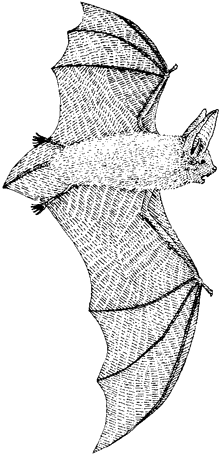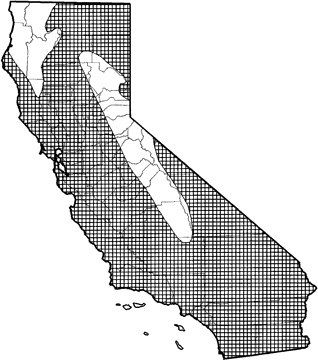
Pallid Bat
Distribution, Abundance, and Seasonality
DISTRIBUTION, ABUNDANCE, AND SEASONALlTY The pallid bat is a locally common species of low elevations in California. It occurs throughout California except for the high Sierra Nevada from Shasta to Kern cos., and the northwestern corner of the state from Del Norte and western Siskiyou cos. to northern Mendocino Co. A wide variety of habitats is occupied, including grasslands, shrublands, woodlands, and forests from sea level up through mixed conifer forests. The species is most common in open, dry habitats with rocky areas for roosting. A yearlong resident in most of the range.

Range Map
Specific Habitat Requirements
Feeding: Takes a wide variety of insects and arachnids, including beetles, orthopterans, homopterans, moths, spiders, scorpions, solpugids, and Jerusalem crickets. The stout skull and dentition of this species allows it to take large, hard-shelled prey. Forages over open ground, usually 0.5-2.5 m (1.6-8 ft) above ground level. Foraging flight is slow and maneuverable with frequent dips, swoops, and short glides. Many prey are taken on the ground. Gleaning is frequently used, and a few prey are taken aerially. Can maneuver well on the ground. May carry large prey to a perch or night roost for consumption. Ingestion of fruit in one study (Howell 1980) was a result of feeding on frugivorous moths. Uses echolocation for obstacle avoidance; possibly utilizes prey-produced sounds while foraging.
Cover: Day roosts are in caves, crevices, mines, and occasionally in hollow trees and buildings. Roost must protect bats from high temperatures. Bats move deeper into cover if temperatures rise. Night roosts may be in more open sites, such as porches and open buildings. Few hibernation sites are known, but probably uses rock crevices.
Reproduction: Maternity colonies form in early April, and may have a dozen to 100 individuals. Males may roost separately or in the nursery colony.
Water: Needs water, but has a good urine-concentrating ability (Geluso 1978).
Pattern: Prefers rocky outcrops, cliffs, and crevices with access to open habitats for foraging.
Species Life History
Activity Patterns: Nocturnal. Hibernates. Emerges late (30-60 min after sunset), with a major activity peak 90-190 min after sunset, and a second peak shortly before dawn. Briefer foraging periods occur in autumn, and activity is infrequent below 2ÁC (35ÁF). Undergoes shallow torpor daily. Hibernates in winter near the summer day roost (Hermanson and O'Shea 1983).
Seasonal Movements / Migration: Makes local movements to hibernation sites. There is a post-breeding season dispersal.
Home Range: Forages 0.5-2.5 km (1-3 mi) from day roost. Capable of homing from distances of a few miles, but not further.
Territory: Social. Most pallid bats (95%) roost in groups of 20, or more, ranging to 162. Group size is important for metabolic economy and growth of young. Young animals occupy the center of clusters. Individuals out of clusters experience higher rates of weight loss (Trune and Slobodchikoff 1976,1978).
Reproduction: Mates from late October-February. Fertilization is delayed, gestation is 53-71 days. Young are born from April-July, mostly from May-June. The average litter is 2, but females reproducing for the first time usually have 1 young. Litter size is 1-3. The altricial young are weaned in 7 wk, and are observed flying in July and August. Females nurse only their own young. Females and juveniles forage together after weaning. Females mate in first autumn, males in second. Maximum recorded longevity is 9 yr,1 mo (Cockrum 1973).
Niche: This slow-flying, maneuverable species is adapted to feed on large, hard-shelled prey on the ground or in foliage. It is known to roost with a number of other bats, principally Myotis spp. and Tadarida brasiliensis. Owls and snakes are known predators.
Comments: Very sensitive to disturbance of roosting sites. Such sites are essential for metabolic economy, juvenile growth and as night roosts to consume prey.
Sources & References
California Department of Fish and Game, 1999.
California's Wildlife, Sacramento, CA.
Written by: J. Harris, reviewed by: P. Brown, edited by: D. Alley, R. Duke
Barbour, R. W., and W. H. Davis. 1969. Bats of America. Univ. of Kentucky Press, Lexington. 286pp. Beck, A. J., and R. L. Rudd. 1960. Nursery colonies in the pallid bat. J. Mammal. 41:266-267. Black, H. L. 1974. A north temperate bat community: structure and prey populations. J. Mammal. 55:138-157. Brown, P. E. 1976. Vocal communication in the pallid bat, Antrozous pallidus. Zeit. Tierpsychol. 41:34-54. Cockrum, E. L. 1973. Additional longevity records for American bats. J. Ariz. Acad. Sci. 8:108-110. Cockrum. E. L., and S. P. Cross. 1964. Time of bat activity over waterholes. J. Mammal. 45:635-636. Davis, R. 1966. Homing performance and homing ability in bats. Ecol. Monogr. 36:201-237. Davis, R. 1969a. Growth and development of young pallid bats, Antrozous pallidus. J. Mammal. 50:729-736. Davis, R. 1969b. Wing loading in pallid bats. J. Mammal. 50:140-144. Dietz, C. L. 1973. Bat walking behavior. J. Mammal. 54:790-792. Easterla, D. A., and J. O. Whitaker, Jr. 1972. Food habits of some bats from Big Bend National Park, Texas. J. Mammal. 53:997-890. Engler, C. H. 1943. Carnivorous activities of big brown and pallid bats. J. Mammal. 24:196-197. Findley, J. S., A. H. Harris, D. E. Wilson, and C. Jones. 1975. Mammals of New Mexico. Univ. New Mexico Press. Albuquerque. 360pp. Freeman, P. W. 1981. Correspondence of food habits and morphology in insectivorous bats. J. Mammal. 62:166-173. Geluso, K. N. 1978. Urine concentrating ability and renal structure of insectivorous bats. J. Mammal. 59:312-323. Hatt, R. T. 1923. Food habits of the Pacific pallid bat. J. Mammal. 4:260-261. Hermanson, J. W., and T. J. O'Shea. 1983. Antrozous pallidus. Mammal. Species No. 213. 8pp. Howell, D. J. 1980. Adaptive variation in diets of desert bats has implications for evolution of feeding strategies. J. Mammal. 61:730-733. Huey, L. M. 1936. Desert pallid bats caught in mouse traps. J. Mammal. 17:285-286. Licht, P., and P. Leitner. 1967. Behavioral responses to high temperatures in three species of California bats. J. Mammal. 48:52-61. O'Farrell, M. J., and W. G. Bradley. 1970. Activity patterns of bats over a desert spring. J. Mammal. 51:18-26. O'Farrell, M. J., W. G. Bradley, and G. W. Jones. 1967. Fall and winter bat activity at a desert spring in southern Nevada. Southwest. Nat. 12:163-171. O'Shea, T. J., and T. A. Vaughan. 1977. Nocturnal and seasonal activities of the pallid bat, Antrozous pallidus. J. Mammal. 58:269-284. Orr, R. T. 1954. Natural history of the pallid bat, Antrozous pallidus (Le Conte). Proc. Calif. Acad. Sci. 18:165-246. Ross, A. 1961. Notes on food habits of bats. J. Mammal. 42:66-71. Ross, A. 1967. Ecological aspects of the food habits of insectivorous bats. Proc. West. Found. Vertebr. Zool. 1:205-264. Trune, D. R., and C. N. Slobodchikoff. 1976. Social effects of roosting on the metabolism of the pallid bat (Antrozous pallidus). J. Mammal. 57:656-663. Trune, D. R., and C. N. Slobodchikoff. 1978. Position of immatures in pallid bat clusters: a case of reciprocal altruism? J. Mammal. 59:193-195. Vaughan, T. A., and T. J. O'Shea. 1976. Roosting ecology of the pallid bat, Antrozous pallidus. J. Mammal. 57:19-42. Whitaker, J. O., Jr., C. Maser, and L. E. Keller. 1977. Food habits of bats of western Oregon. Northwest Sci. 51:46-55.
California Animal Facts | California's Wildlife